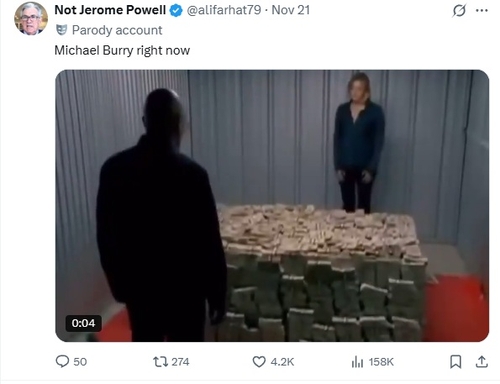
(Seoul=Yonhap Infomax) International Economics Department = As shares of major technology companies such as Nvidia Corp. (NASDAQ: NVDA) underwent a correction last week—echoing the outlook of Michael Burry, the protagonist of the film "The Big Short"—Burry has become a popular meme across the internet.
According to Business Insider on the 23rd (local time), Burry highlighted concerns about Nvidia’s chip lifespan and circular transactions among artificial intelligence (AI) firms via social media platform X (formerly Twitter) following Nvidia’s strong Q3 earnings report.
After Nvidia’s shares surged more than 5% in after-hours trading post-earnings, some market participants mocked Burry’s bearish outlook, portraying his challenge to the AI frenzy as comical.
One X account posted an image of a bear relaxing by the sea or sitting on a park bench, captioned “Michael Burry’s look.” The bear symbolizes a bearish market.
Another account joked, “Burry will 100% get a margin call tomorrow,” accompanied by a laughing emoji, after Nvidia’s earnings release.
However, on November 20, Nvidia’s shares, after an initial rise during regular U.S. trading, closed down 3%, and fell an additional 1% on the 21st.
This reversal has sparked a trend of supporting Burry and consuming his persona as a meme in the market.
Burry operates on X under the name “Cassandra”—a reference to the cursed priestess in Greek mythology who made accurate prophecies that no one believed.
The X account “Wall Street Maverick” posted a screenshot from “The Big Short” with the caption, “Cassandra won. Brutal day.”
Another account shared a video of a man standing before a mountain of cash, captioned “Current Michael Burry.”
Burry has not shown any particular reaction to these memes. (Ji Yeon Kim)
“Americans Extending Device Replacement Cycles—A Drag on the Economy”
Americans are increasingly lengthening the replacement cycle for devices such as smartphones.
According to CNBC on the 23rd (local time), a recent survey by Reviews.org found that the average smartphone usage period among Americans has risen to 29 months, up significantly from 22 months in 2016.
While maximizing device lifespan can reduce user costs in the short term, experts warn that it may lead to hidden costs such as reduced productivity and economic inefficiency over the long term.
According to a Federal Reserve study released last month, each year that companies delay equipment upgrades results in a roughly 0.3% decline in productivity. The study also found that about 55% of productivity gaps among advanced economies stem from differences in investment pace. U.S. firms generally reinvest in replacing aging equipment faster than their European counterparts.
CNBC explained, “While using devices longer may seem financially prudent, it can result in significant losses in productivity and innovation across the broader economy.” (Yong Wook Kwon)
“Hong Kong and Singapore Office Rents to Reach Parity by 2027”
Office rents in Hong Kong and Singapore, Asia’s two leading financial hubs, are projected to reach parity by 2027.
According to the South China Morning Post (SCMP) on the 24th (local time), CBRE forecasts that prime office rents in Hong Kong will reach $122 per square foot annually in Q4 2027.
Singapore’s rents are expected to be about $123 per square foot per year, bringing the two cities’ office rents to similar levels.
Historically, Hong Kong’s rents were higher, but the gap is now set to disappear.
In Q1 2017, prime office rents in Hong Kong stood at $196 per square foot, compared to $77 in Singapore. However, the gap has narrowed in recent quarters, with the current difference at just 10%.
Currently, Hong Kong’s prime office rents are $126 per square foot, while Singapore’s are at $114.
CBRE attributes the narrowing gap to increased office supply and persistently high vacancy rates in Hong Kong.
CBRE also noted that lower rents in Hong Kong could influence corporate decisions on workforce allocation between the two cities. However, given Hong Kong’s close economic ties to mainland China, the city could be more vulnerable if U.S.-China relations deteriorate. (Kyung Pyo Hong)
US Treasury Secretary Voices Concern Over Beef Prices—No Signs of Easing
US economists say persistent demand is driving up beef prices, with little sign of relief in sight, Fox Business reported on the 23rd (local time).
Glynn Tonsor, professor of agricultural economics at Kansas State University, noted that strong consumer demand continues to push beef prices higher.
“No one is forced to pay more for beef at the grocery store—people are choosing to do so,” Tonsor said. “Consumers’ strong desire for beef is driving prices up, regardless of supply conditions.”
According to US Department of Agriculture (USDA) data, the average retail price of beef rose about 9% from $8.40 per pound in March to $9.18 per pound in August 2025.
Nonetheless, US beef consumption continues to rise.
The National Cattlemen’s Beef Association (NCBA) reported that in 2024, US consumers spent over $40 billion on fresh beef, accounting for more than half of all fresh meat sales.
On the supply side, years of drought, high feed costs, and an aging rancher population have reduced cattle herds nationwide, bringing the herd size to its lowest level in 70 years.
Deral Peel, professor of agricultural economics at Oklahoma State University, said the current supply crisis will not be resolved overnight.
“There’s no quick fix for the current situation,” Peel said. “It took years to reach this supply shortage, and it will take years to recover.”
Meanwhile, US Treasury Secretary Scott Besant, in an earlier interview with Fox Business, called the prospect of beef prices reaching $10 per pound next year a “perfect storm,” adding, “We inherited terrible inflation.” (Min Jae Lee)
jykim@yna.co.kr
(End)
Copyright © Yonhap Infomax Unauthorized reproduction and redistribution prohibited.

